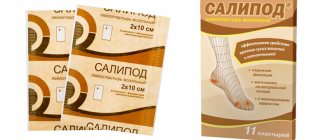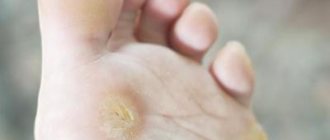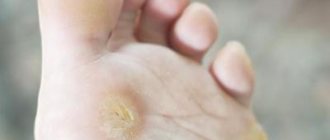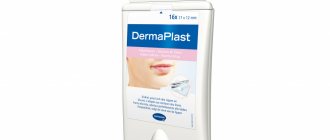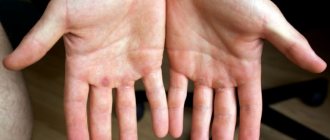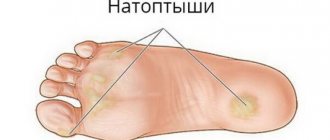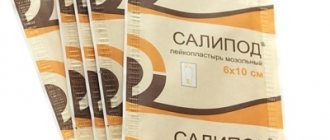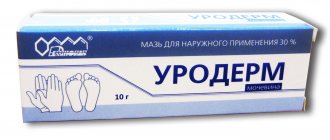Calluses or hyperkeratoses are local changes in the skin associated with exposure to damaging factors on an area of the body.
Literally translated, “hyperkeratosis” means “excess of keratin,” a substance that causes hardening.
The skin loses its elasticity, becomes less sensitive to external influences, and feels rough to the touch.
Defects in ICD10 are allocated to a special nosological group L84 - “Calls and calluses”.
Mostly calluses form on the skin of the hands and feet, where the epidermis (skin) contains, among others, a shiny layer.
It provides increased skin density as an adaptation to external pressure or friction.
As a result, the skin becomes denser in defense and calluses form.
Composition and release form
The thin polyurethane base gives the product wear resistance and makes it possible to use it with different types of shoes. Therapeutic and hygienic products are made from lightweight polymers, which makes the patch practically imperceptible on the body.
Compeed are highly elastic, do not wrinkle and are able to take any configuration, exactly following the contours of the leg. They help to avoid discomfort and pain when breaking in new shoes or boots.
The action of the product begins almost instantly after gluing. Compeed is water-resistant, so even when wet, the fixation on the surface of the skin does not weaken. It is well ventilated and accelerates the healing of any dermatological destruction.
Compide is a patch for wet calluses that effectively anesthetizes the damaged surface of the epidermis and prevents wound infection. Hygienic products are produced in the form of adhesive polymer flaps of various geometric configurations and dimensions or small disks.
The composition of the patches depends on the type and purpose of the product.
All models contain the following components:
| Substance | Description and functions |
| Gum | An adhesive layer based on a high-molecular carbon compound of natural origin. |
| elastomer | Polymer of high elasticity, resilience and viscosity. Gives the patch flexibility. |
| plasticizers | They facilitate the dispersion of components and increase the product’s resistance to low temperatures. |
| Hydrocolloid elements | Hydrophilic polymers that maintain a moist environment on the damaged skin area and accelerate wound healing. |
| polyurethane | Heterochain plastic material that gives Compid resistance to abrasion. |
| Plant resins | Makes the patch waterproof and dust-repellent. |
This composition gives Compeed patches hygienic, bactericidal, and ventilation properties. Under the influence of the product, calluses first decrease in size and then completely disappear.
Kinds
Johnson & Johnson produces adhesive medical and hygiene products for various purposes.
There are 6 types of Compid patches:
- Medium Callous – for corns. The product contains special healing components of natural origin that effectively affect the surface and deep layers of the epidermis and have a softening effect. Approximate price – 180 rubles.
- Corn plasters – for dry calluses. The components that make up its chemical formula eliminate keratinization of the skin, relieve redness and inflammation. The approximate cost in Russian pharmacies is 160 rubles.
- Soothing Blister Relief – for blisters and wet calluses. The composition is saturated with special drying ingredients. The product has a breathable structure, absorbs liquid well, and prevents the development of pathogenic microflora in the destructive zone. For a pack of 6 pcs. in a Russian pharmacy you will have to pay about 260 rubles.
- Active Corn – against ingrown and deep calluses. The patch saturates the epidermis with nutrients and analgesics, simultaneously softening and moisturizing it. The remedy relieves pain and eliminates old destruction of the epidermis. Price for a pack of 5 pcs. is 250 rubles.
- Compeed Pencil is a preventive patch that prevents the formation of calluses of any type. Creates a thin protective film on the skin surface, which reduces friction when wearing new shoes. Price – 290 rub.
- Total Care Invisible Cold Sore Patch – against herpes and other bacterial infections. It is distinguished by the presence of antiseptic properties. Price – 300 rub.
Compid is a patch for wet calluses and other types of destructive changes in the epidermis, which should be used only for its intended purpose.
Purpose
Each package of hygiene products is supplied with instructions for use. It indicates what type of callus the product is intended for. Compid effectively eliminates destructive formations of various etiologies and localizations.
Indications for use:
- keratinized layers;
- deeply ingrown calluses;
- abrasions between the toes, on the heel, on the foot;
- epidermal cracks;
- exudate-filled and inflamed areas of the skin;
- growths;
- bacterial and fungal infections.
The Compid line of hydrocolloid products prevents dust particles, dirt, and any foreign elements from entering open wounds. The patch protects damaged areas of the epidermis from mechanical pressure, temperature and chemical influences.
Which plaster for calluses is better?
- the one that is applied to the callus in a timely manner
- corresponds to the type of callus
- Fits tightly and is easy to remove
- does not cause allergic reactions
If the patch for calluses does not provide the required effect, you should contact a podologist or podiatrist, a specialist in therapeutic (medical) pedicure.
A cosmetologist or cosmetology nurse will also help get rid of defects.
In more serious cases, it is necessary to visit a dermatologist, mycologist or simply a surgeon
Contraindications
The product is well tolerated by people with any skin type and a tendency to allergic reactions. However, there are some clinical contraindications for use.
These include:
- hypersensitivity to the components of the patch;
- deep cuts in the skin, if the active ingredients of the colloidal product get into them, they can cause burning or itching;
- severe diabetes mellitus and other endocrine disorders requiring prior consultation with a doctor;
- chronic dermatological pathologies in the area of application;
Do not apply the product after its expiration date.
How to treat calluses at home
The best way to treat calluses at home, without involving a doctor, is to use special patches.
Pharmacies often offer a variety of products targeting different types of calluses.
Each patch has instructions included in the packaging or printed directly on it.
Mode of application:
- The limb should be lightly steamed and blotted dry.
- Lubricate the healthy part of the skin around the callus with baby cream or Vaseline.
- Remove the protection, place the membrane impregnated with the medicinal composition strictly on the skin defect
- Fix the patch and wear for 1-2 days
Operating principle
The colloidal product softens the skin, gives it a healthy appearance and elasticity. The patch quickly absorbs exudate, drying the open wound. The chemical formula of the hygiene product for dry calluses contains salicylic acid, which is applied to the central part of the tape.
The substance comes into direct contact with the damaged area of the skin.
The medicinal product contains components that have the following effects:
- reduce pain from calluses, abrasions, and wounds on the legs;
- facilitate walking in case of destruction of the epidermis;
- moisturize rough areas of the skin;
- accelerate the healing of cuts;
- eliminate fungal infections;
- suppress the activity of pathogenic microorganisms.
After gluing the tape, salicylic acid is released and penetrates into the deep layers of the destructively altered area, restoring the natural structure of the epidermis. Additionally, the product softens tissue, blocks the wound surface from the external environment and relieves pain.
Compide is a patch for wet calluses that prevents the emergence of pathogenic microflora, since it creates unfavorable conditions for its development. Under the influence of biologically active components, healing of damaged areas occurs as quickly as possible.
In destructively altered tissues, cellular regeneration processes are launched. Special polymer components of the patch simultaneously polish the skin, giving it smoothness and removing keratinized elements from the surface.
The polyurethane base of the colloidal product provides free access to the damaged area of the air mixture. Due to such natural ventilation, diaper rash does not form.
Classification of calluses
A dry callus is a limited area of yellowish, keratinized, thickened, dense skin.
Painful when located at the base of the fingers on the plantar or palmar surface.
Calluses on the heels lead to the formation of cracks, which can become painful and become infected.
Causes of dry calluses:
- work in a standing position
- long walk
- tight and narrow shoes
- working with tools (construction, musical, sports, power tools)
- dry skin where calluses form
- thinning of subcutaneous fat in areas where calluses form
A soft callus—otherwise known as a wet callus—is saturated with moisture and softens, forming blisters.
Microtraumas cause inflammation with damage to the deep layers of the skin.
Under the pressure of the released interstitial fluid, the surface epidermis rises.
Moisture sweats inside and bubbles form.
A typical place for the formation of such calluses is the interdigital folds.
Such calluses cause extreme pain and are dangerous when the bladder is opened due to the risk of infection.
Causes of soft calluses:
- microtraumas and cracks
- wet skin where calluses form
- thinning of the skin and subcutaneous fat
- tight shoes or tight wet gloves
- wet socks or stockings
- increased sweating of the feet
- thinning of the skin and infection
A core (or “ingrown”) callus is a dense, round area of hyperkeratosis.
With clear boundaries and a hard transparent whitish rod in the center, when viewed it resembles a lid.
They are formed in response to injury by a foreign body (stone, splinter) in places where bone bases press on soft tissue.
The rod consists of a stratum corneum, as hard as a nail plate.
Therefore, when vertical pressure is applied to the callus, severe pain is felt due to compression of the dermal nerves.
Callus must be distinguished from plantar warts, since the treatment indicated is different.
A plantar wart is similar in appearance to a callus, but its surface looks loose, with brown dots.
And pain appears with any pressure, including from the sides.
There is usually only one core callus, and small, daughter similar formations form next to the large wart.
Causes of callus formation:
- high heels shoes
- work in a standing position
- untreated soft callus
- viral and fungal infections
- microtrauma of the skin
- constant pressure or rubbing of a specific area of skin
- diabetes
- flat feet
Subungual keratosis, in which the nail folds appear as thickenings on the side of the nail plate in the form of a dense yellow-gray mass.
The nail becomes dense, dull, deformed, and partially destroyed on both sides.
Such formation may indicate a fungal infection of the nail.
Therefore, you should see a mycologist, as well as the development of panaritium or an ingrown nail.
Reasons for the formation of subungual keratosis:
- failure to comply with hygiene rules
- diabetes mellitus (diabetic foot)
- violation of the trophism of the skin of the feet
- nail phalanx injuries
Corns are areas of hardened skin on the plantar surface of the foot.
Causes of corns formation:
- tight shoes with insufficiently rigid and thin soles (calluses in the heel area)
- high heels (corns in the big toe area)
- displacement of the center of gravity with valgus or varus position of the feet (corns on the lateral surface of the foot)
- Reduced spring function of the foot due to flat feet (calluses all over the sole)
Children more often develop soft (“wet”, “weeping”) calluses that look like a bubble with liquid.
Reasons for the formation of a soft callus with a blister in children:
- Tight shoes
- Shoes with rough seams, made of leatherette
- Shoes that are too big (not the right size)
- Large socks or tights that bunch up when wearing shoes
In women, soft (“wet”) calluses are more common on the upper extremities when working in their summer cottage or in places where they are compressed by tight shoes.
Often, core and dry types of calluses appear as a result of constant pressure or friction.
For example, when working with sports (stick, dumbbells, barbells, clubs) or athletic (mechanical and electrical simulators) equipment.
Or when constantly carrying heavy loads.
Dry calluses are common among musicians, in particular on the fingers of a guitarist or calluses on the fingers and chin of a violinist.
Older people can develop all types of calluses.
Age-related dry skin stimulates the formation of dry calluses and corns.
Thinning of the skin leads to cracks and the formation of wet calluses; ingrown toenails are formed due to poor foot hygiene against the background of subungual keratosis.
Painful sensations and impaired sensitivity of the feet lead to the risk of falls in an elderly person, or even refusal to walk.
With a long course of the disease, bedsores may appear on the feet.
Advantages
The treatment eliminates destructive formations on the skin, rather than masks them.
The main advantages of Compeed patches:
- rapid absorption of exudate from the wound surface;
- flesh-colored ribbon can be worn discreetly, which does not cause difficulties for women when wearing sandals or open shoes;
- the special design of the product ensures proper ventilation, good heat exchange, and effectively removes sweat;
- special components of the chemical formula of the product prevent the appearance of unaesthetic scars at the site of a healed wound;
A variety of shapes and sizes ensures the comfort of using Compeed patches. The colloidal product is characterized by high strength, abrasion resistance, and dust-repellent properties.
Therefore, you can wear it for a long time until the calluses are completely healed. When used and in constant contact with tight shoes, the adhesive tape does not roll or crumple.
This prevents re-injury of the protected surface of the skin. The thin patch is not felt at all on the body and causes not the slightest discomfort. Absolute waterproofness allows you not to remove the product in the bath or shower.
This property also protects the open wound from excessive moisture and exposure to shampoo and soap, which can cause irritation of the injured area, unpleasant itching, and burning. The Compeed patch allows you to do without other medications and antiseptics.
Preventing the formation of calluses
- hygiene of the skin of the feet and hands, timely pedicure
- maintaining sufficient skin hydration
- avoid wet hands and feet (socks, gloves, prolonged exposure of hands and feet to water)
- comfortable shoes that fit well, with a wide toe and a hard heel
- shoes with dense soles with some elevation in the heel area, well-finished edges, smooth insoles
- changing shoes several times during the season
- massage of hands and feet, therapeutic exercises
- thorough treatment of soft and dry calluses, avoiding complications
- avoid microtraumas, including permanent traumatization by a foreign body
- don't cut calluses
- use protective plasters if there is a risk of callus formation
If calluses appear, contact the author of this article, a dermatologist in Moscow with many years of experience.
How to choose the right patch?
The variety of options for such products allows you to purchase the product in accordance with the nature and type of dermatological destruction. But at the same time, this makes the choice much more difficult.
When purchasing Compeed patches, you should be guided by:
- type of calluses;
- localization of education;
- physicochemical characteristics of damage.
To make the task easier for ordinary consumers, the manufacturer indicates on the packaging in large print the purpose of the colloidal adhesive pads. The main thing is to independently determine the type of skin damage that needs to be eliminated.
Compid patches are available for wet calluses, dry calluses and others. Depending on the area of application, you can select a therapeutic and prophylactic sticker of the desired shape and size.
There are patches designed specifically to eliminate calluses and abrasions in the interdigital area of the feet. Such products have increased wear resistance and have a special geometrically precise configuration.
They are poorly suited for use on other areas of the legs. This applies to the entire range of Compeed patches. Such products should not be used for other than their intended purpose.
In this case, their effectiveness will be quite low. The correct choice of a patch will prevent it from slipping during use and will ensure the most effective effect on the type of dermatological destruction for which it is designed.
Mode of application
To achieve the proper therapeutic effect, you must follow the manufacturer's recommendations. For each type of patch, they differ according to the purpose of the colloidal products.
General step-by-step instructions for use:
- It is necessary to clean and dry the wound surface.
- Then the patch must be heated in your hands to the temperature of the human body in order to activate the active ingredients of its formula and avoid discomfort when sticking.
- The product is applied to the center of the lesion and slightly smoothed towards the edges.
- It is necessary to lightly move your fingers over the patch to remove air sinuses until there is a tight adhesion to the surface of the skin.
If applied carelessly, when the active ingredients of the colloidal product do not reach the affected area, skin irritation or mild itching is possible. This occurs due to the acute reaction of healthy tissues to the action of the active components of the patch.
For wet calluses
This product is coated with a substance with bactericidal properties and increased hygroscopicity. Its active ingredients prevent drying of the damaged skin area.
Recommendations for use:
- The surface of the epidermis is treated with warm water and chemically neutral toilet soap.
- Clean the edges of a wound filled with exudate from keratinized fragments
- The skin area is dried.
- Remove the protective film from the patch and apply it tightly with the adhesive side to the damaged area.
The absorption of exudate is noticeable by a wet spot on the back of the colloidal product. The patch must be applied carefully and always the first time.
Otherwise, the sticky layer will further damage the wound, which will cause pain.
For dry calluses
When this type of destructive changes occurs in the skin, it is important to use the Compeed patch in a timely manner. It moisturizes the wound and softens keratinized tissue thanks to the hydrocolloid component included in its composition. A special polymer coating provides reliable adhesion to the skin surface and prevents premature peeling.
How to use the product:
- First you need to steam your feet in hot water with sea salt.
- Then you should wipe the skin dry with a towel and gently blot the damaged area.
- Next, the patch is heated in your hands and the protective film is removed from its sticky side.
- Apply the tape or disc tightly to the damaged area.
Compide (a patch for wet or dry calluses) is used in almost the same way. It is important that the active substance gets exactly into the place intended for therapeutic effect. Dry calluses will soften in about 2 days and begin to gradually disappear.
For corns on the soles
This product contains in its multilayer design a special gel-like component with analgesic properties and the ability to penetrate the internal structure of the destructive area. The patch instantly relieves pain and quickly moisturizes the epidermis.
You need to use it as follows:
- First, the skin is steamed in a bath with a solution of hot water, table salt and baking soda.
- Use a pumice stone or a special cosmetic brush to remove dead layers.
- Then the surface of the skin intended for therapeutic treatment is dried.
- Remove the protective film from the patch.
- The colloidal product is pressed tightly with the adhesive side to the corn.
Within 2-3 days, the callus will begin to decrease in size, and the natural structure of the epidermis will be restored. Complete healing is observed after a week. The salicylic acid included in the therapeutic product moisturizes keratinized layers, and sulfur compounds dissolve and remove them.
For ingrown calluses
Hydrocolloid components create a moist mineral environment in and around the body of the rod. Vitamin supplements and bioactive elements accelerate cell regeneration. Therefore, ingrown calluses quickly disappear naturally.
Before applying the patch, the skin must be thoroughly steamed and carefully treated with a pumice stone or a cosmetic scraper. Then the surface of the epidermis is thoroughly dried.
Apply the patch after removing the protective coating from its adhesive side. The colloidal polymer provides a kind of greenhouse effect in the callosal formation, due to which it gradually collapses. The product prevents the formation of cracks and eliminates pain.
For herpes
The active ingredient of this patch is hydrocolloid-075, which effectively absorbs wound secretions.
Auxiliary components:
Compid antiherpetic patch
- gelatin is a partially hydrolyzed collagen protein of animal origin, which restores the natural structure of affected epithelial cells;
- croscarmellose sodium - a chemical compound with a high ability to absorb exudate;
- plant resins that perform a barrier function;
- a polyurethane base that ensures the tightness of the active components of the patch.
The therapeutic agent protects the wound from external influences and bacterial colonization. The Compeed anti-herpes patch is a transparent film that is completely invisible on the body.
It can be glued to the face by applying makeup on top, which adheres perfectly due to the high adhesive properties of polyurethane. It is recommended to use a colloidal product at an early stage of a dermatological disease - at the first signs of herpes.
In this case, the Compeed patch demonstrates the greatest effectiveness, quickly extinguishing the inflammatory process and destroying pathogenic microflora in the phase of its development. Before gluing the product, it is necessary to wash the affected area of skin with toilet soap or antiseptic cosmetic milk, and wipe thoroughly with a towel or napkin.
Advantages and disadvantages of using the patch
The adhesive plaster for skin growths is an elastic base with a fabric layer impregnated with active substances. The effectiveness of the product is high. Removing the formation takes a short period of time. During this time, the superficial stratum corneum of the wart dissolves, subsequent tissues soften and can be easily removed mechanically using a file, pumice stone and other means.
In addition to the main substance that has a keratolytic effect, many manufacturers add an antimicrobial, drying component to the composition. This allows you to prevent the addition of a secondary bacterial or fungal infection.
The drug is inexpensive and provides comprehensive treatment.
The main disadvantage is the need for long-term wearing and regular replacement to achieve a lasting therapeutic effect. This increases the risk of irritation and allergic reactions of healthy tissue.
Special instructions for use
Before purchasing a patch, you need to accurately determine the type of callus formation and its location. The appropriate type of remedy depends on this. The patch should not be applied to a freshly washed surface.
It must first be wiped and degreased to ensure high-quality adhesion of the adhesive layer to the skin and create a tightness in the wound hole. When using an antiherpes drug during pregnancy and lactation, medical consultation is required.
It is forbidden to tear off the bandage from the wound. This will lead to its opening and the risk of suppuration. Do not cover the patch with antiseptic ointments, creams, or disinfectant lotions. Otherwise, the effectiveness of the therapeutic effect will sharply decrease.
The product peels off on its own after completion of the treatment procedure and the consumption of its active ingredients. The Compid patch for wet, dry or ingrown calluses acts in a similar way and falls off without outside intervention.
Article design: Vladimir the Great
